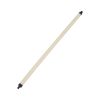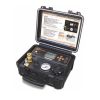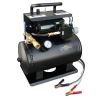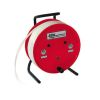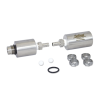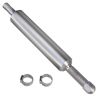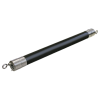Solinst Model 407 Bladder Pumps
Features
- Consistently accurate samples with excellent VOC sample integrity
- Pneumatic drive pumps are well suited for pumping contaminant liquids
- Bladders are not damaged by operation in sediment laden water, or in dry pumping conditions
- Free ground shipping
- Expedited repair and warranty service
- Lifetime technical support
- More
The Solinst Bladder Pump features a new design providing consistent, high-quality samples in all types of applications. It offers excellent performance and reliability. With Solinst Bladder Pumps, there is the assurance that there is no air/water contact during sampling. It meets the most rigorous US EPA standards for VOC groundwater monitoring.
The bladder guarantees that drive air or gas does not contact the sample, thus avoiding degassing or contamination. Solinst Bladder Pumps are rugged and long-lasting. Santoprene bladders are ideal for dedication, however, the new easy-to-replace bladder cartridges are excellent for those who prefer to change bladders after each use. The bladder and intake filters are simply replaced in the field in just a few minutes—no special tools are required.
Excellent for either regular flow or low flow sampling, the stainless steel pumps can lift from depths up to 150 m (500 ft) below grade. The new PVC Bladder Pump operates up to 100 ft (30 m) below grade.
In The News
Floating Global New Ideas: Buoy-Enabled Research at Florida Agricultural and Mechanical University’s School of the Environment
Florida Agricultural and Mechanical University (FAMU), based in Tallahassee, Florida, is the highest-rated public Historically Black College or University in the United States. FAMU’s School of the Environment (FAMU-SOE) offers BS and BA degrees in Environmental Studies, and BS, MS, and Ph.D. degrees in Environmental Science, with specialisms available in areas including Environmental Policy and Risk Management, Aquatic and Terrestrial Ecology, and Biomolecular Sciences. In 2021, FAMU-SOE deployed a NexSens CB-450 buoy in Apalachee Bay, a key oyster farming area around 30 miles south of Tallahassee. The buoy has quickly been incorporated into the curriculum, providing environmental insights for student research, the community, and beyond. Dr.
Read MoreMonitoring Habitat Suitability and Water Quality in Northwest Arkansas Springs
Northwest Arkansas has seen an economic, industrial, and population boom in recent years as a result of expanding businesses, which have created thousands of jobs in the region and the mass migration of employees and construction companies. However, with this growth has come rapid urbanization and the degradation of the natural landscape, specifically the freshwater springs that can be found throughout the region. These springs are critical habitat centers for native wildlife, home to threatened and endangered fish, and those that have yet to be listed. Zach Moran, Assistant Professor of Fisheries Science at Arkansas Technical University, is working to help monitor these habitats and provide key data that will hopefully inform future development in the region.
Read MoreThree Decades of Research at Acton Lake
A multi-disciplinary team at Miami University, Ohio, has been studying the environmental change at Acton Lake for over three decades. Using three different NexSens buoys over this time, the team has an incredible archive of data that is helping build a picture of Acton’s past, present, and future. Until recently, a NexSens CB-50 buoy was used alongside other environmental monitoring at Acton Lake. In May 2025, the Miami team deployed a new XB-200 buoy , future-proofing their ongoing monitoring using real-time buoy systems. Acton Lake, a small hypereutrophic reservoir in southwest Ohio, covers 2.4km² and has a maximum depth of about 8m. The dam was built in 1956, and the lake has a large agricultural watershed.
Read More






















